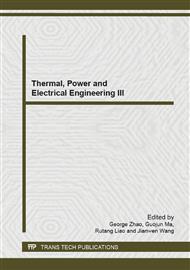p.1237
p.1243
p.1248
p.1254
p.1258
p.1264
p.1268
p.1272
p.1277
Study of a Small-Scale Controllable Reactor and Conceptual Design of a 35kV/5Mvar HTS Reactor
Abstract:
Since Ultra High Voltage (UHV) transmission lines have the high charging capacitance, continuous reactive power compensation is vital for efficient operation of long transmission power lines or cables. A continuous reactive compensation will reduce the transmission losses and increase the transmission capacity of active power. In order to achieve the continuous reactive power compensation, we choose the magnetic saturable type reactor. The principle of a magnetic saturable reactor requires a high current ampere-turn coil as its dc bias, and this coil is necessary to use a high temperature superconducting (HTS) winding. As the first stage of the study, we have constructed a 220V small-scale prototype which the dc bias is made of copper coil instead of the HTS coil. The copper coil of the dc bias in small-scale reactor has the same ampere-turn with a 220V HTS controllable reactor (HCR), so its performance keeps the same except the HTS part. Based on this, we made a conceptual design for a 35kV/5Mvar HCR. The output property and harmonic property have been studied by simulation and experiment. The results prove that it can obtain a continuous controllable reactive power output.
Info:
Periodical:
Pages:
1258-1263
Citation:
Online since:
June 2014
Authors:
Price:
Сopyright:
© 2014 Trans Tech Publications Ltd. All Rights Reserved
Share:
Citation:


